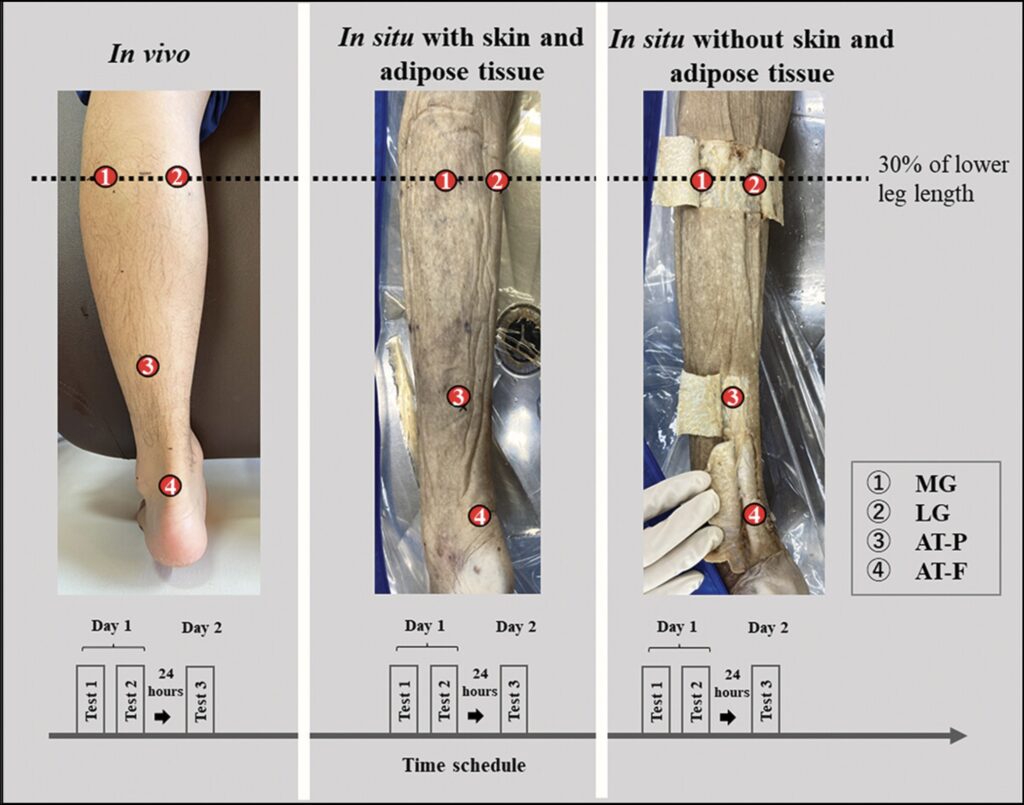Publications

Biomechanical assessment of gastrocnemii and Achilles tendon using MyotonPRO: in vivo measurements, and preliminary in situ measurements using formalin-fixed tissues
Authors: Xiyao Shan, Kanae Umemoto, Takuro Ishikawa, Kaori Fukushige, Takao Takeuchi, Munekazu Naito
Affiliations:
Department of Anatomy, School of Medicine, Aichi Medical University, Nagakute, Japan
Journal: Connective Tissue Research - October 2023, Volume 65, Issue 1, Pages 16-25 (DOI: 10.1080/03008207.2023.2267682)
-
Field & Applications:
- Reliability
- Validity
- The results in vivo showed a very high reliability of the mechanical properties of the muscles and tendons.
- Our findings fill the reporting gap on the reliability of the MyotonPRO for Achilles tendon research.
- The results of the current study suggest that MyotonPRO is reliable to evaluate cadaveric tendinous tissues’ stiffness.
Purpose: This study aims to evaluate the reliability and validity of using MyotonPRO to quantify the mechanical properties of the muscle-tendon unit through in vivo measurements and preliminary in situ measurements using formalin-fixed tissues.
Materials and Methods: The mechanical properties of gastrocnemii and the Achilles tendon of 12 healthy adults (six males and six females, 34.9 ± 5.8 years) were examined for in vivo test twice within a day and once post-24 hours using MyotonPRO, while nine human cadavers (formalin-fixed, 3 males and 6 females, 89.9 ± 5.1 years) were assessed for preliminary in situ test with identical time schedule to evaluate the within-day and inter-day reliability and validity.
Results: In vivo tests had very high within-day (ICC: 0.96–0.99) and inter-day reliability (ICC: 0.83–0.96), while in situ tests (formalin-fixed tissues) showed high within-day (ICC: 0.87–0.99) and inter-day reliability (ICC: 0.76–0.98) for the results of tone and stiffness. There was no significant difference in the stiffness of the free part of the Achilles tendon between in vivo and in situ conditions. The stiffness of the lateral gastrocnemius (r = 0.55, p = 0.018), proximal part of the Achilles tendon (r = 0.56, p = 0.015), and free part of the Achilles tendon (r = 0.47, p = 0.048) before removing the skin was significantly correlated with that after removing the skin condition.
Conclusions: The findings of the current study suggest that MyotonPRO is reliable and valid for evaluating tendon stiffness both in vivo and in situ (formalin-fixed tissues).

Figure 2. Measurement diagram of the MyotonPRO during in vivo, in situ W, and in situ WO conditions. Note: LG, lateral gastrocnemius; MG, medial gastrocnemius; AT-P, Achilles tendon proximal portion; AT-F, Achilles tendon free portion. The cadavers for in situ measurement were formalin-fixed.
Keywords: cadaveric study, tendon stiffness, tone, reliability, validity
In the present study, we measured the mechanical properties of gastrocnemii and the Achilles tendon using MyotonPRO through in vivo and preliminary in situ measurements using formalin-fixed tissues. To our knowledge, this study was the first to assess the reliability and validity of the MyotonPRO when testing on cadaveric tissues (formalin-fixed tissues). Unlike the tensile test of isolated tissue, in situ studies using MyotonPRO make it possible to explore the original structural characteristics and mechanical distribution within the muscle-tendon unit. The results will influence future research design and help to bridge the gap between cadaveric and in vivo assessments of the mechanical properties of muscle-tendon units.


